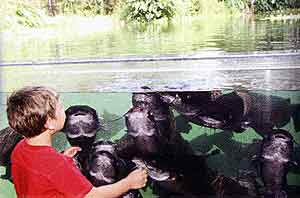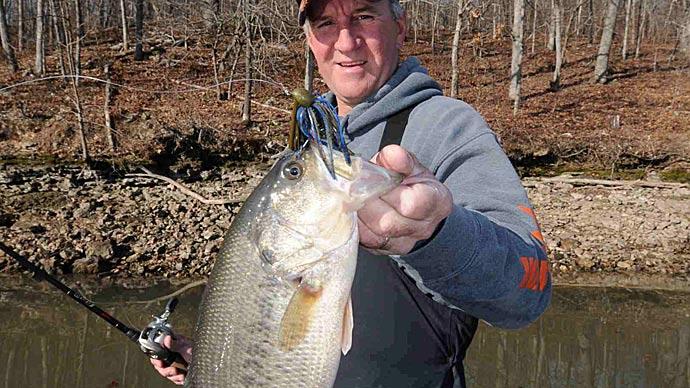
Two years ago, a landowner in east Texas built a nice-sized pond, close to three acres. It sits adjacent to a site where he was preparing to build a lake. Part of the lake site had been excavated and the earthmover found a thick, gooey layer of material that compacted better than any he'd ever seen. Since the small pond had some sand in the bottom, the decision was made to line the bottom with some of that compactable material from the lake site bottom.
With dirt work done, some help from rain, and an assist from a nearby well, that little pond was full and ready to stock with fish. We'd contracted to raise some feed-trained bass with a fish farmer, so we brought some nice ones to stock. Most were at least three pounds.
The driver took his time, tempered the fish properly to prepare them for their new home. They swam off, happy.
So it seemed.
Early the next morning, the ranch manager called. The fish were dead—all of them floating. As a long time biologist, my first thoughts turned to handling. Those fish must've been handled poorly. After a few phone calls, I was scratching my head. I hated those fish died, and I hated having to eat the cost of them, more.
To speed up the story, I decided to check the water chemistry. That triggered a landslide of testing, which ended up being a cause and effect chain of decisions that, at least in my mind, saved the big new lake about to be built.
Here's what happened. The pH of that pond was 3.2. That's way low—acid water. I checked the well. It was close to 5.0, also too low. As I scratched my head and began to call others who know much more about this stuff than I do, it made no sense that well water could drop in pH without some outside influence. It couldn't have been the fresh rain, either. On its worst day in east Texas, pH of rain rarely drops below 6.3. It was a mystery, at least for a short period of time. As I stood by the shore of that little pond, I noticed a red tinge to the bottom mud, that black gooey stuff that held water so well. I made a mental note.
After a round of phone calls and more testing, it dawned on me. It had to be the dirt. We tested the soil and it wasn't so abnormal as I hoped. That is, until water and air hit it. It began oxidizing iron and began to release its free hydrogen ions so fast the buffering capacity the water might have had was quickly taken up by the fleeing by-product—acid.
The soil was the culprit. We fixed that problem by adding lime, neutralizing the water, draining the pond and then disking lime into the black stuff, covering it with a thick layer of native clay and then calling it good.
At the time, we were puzzled. And, this situation made me think about those fish. Why did they die? The simple answer was acid poisoning. But, how does this help you?
That made my brain start to think, and spurred my curiosity into action.

Bass can't live much below a pH of 4.5. They stop being able to reproduce somewhere around 5.0. The topside pH is around 9.0. They are most happy between 6.5 and 8.0. But, even though they can't tolerate the entire range of pH, the range they do have is remarkable. You see, bass have the ability to regulate their internal pH. So do other species offish. Each fish has its own upper and lower limits. Some are more tolerant of acid, some are less tolerant.
Fish are heavily influenced by their environment. Their temperature is the same as the water. The chemistry of the water influences them, too. Bass have an almost magical way of continually adjusting and maintaining the pH of their blood and other fluids by expelling extra acid ions via their urine. They can also breathe faster, removing carbon dioxide from their blood to raise its pH as needed.
Fish can metabolize not only their food, but with the different mechanisms within their bodies, they can rid themselves of some of these natural chemical components, too.
I'll always remember a lake I sampled years ago west of Fort Worth, Texas. This lake was built amongst the spoils piles surrounding an old mining site. Coal was mined and used for furnaces to make brick from nearby heavy clay. Those bricks were not only used for buildings, they were used for streets. To this day, red bricks from that area line streets in Fort Worth.
Anyway, as the electrofishing boat made its round over that lake, I saw something floating in the water. It looked like some sort of scat to me. Beavers, maybe? Beaver scat is sawdust. This stuff wasn't sawdust. It was rock hard, but lightweight. As I looked, it WAS rock and looked something akin to lava. I'd never seen floating rocks, ever. We shocked up some fish, mostly bluegills. They looked terrible — eye sockets were deformed and fins were shrunken. It hit me. I checked the pH. It was 4.0, by my little test kit. That was the most acidic water I'd ever seen, up to that point in my career. As I studied that fishery, all the bluegills were adults. There were no young ones. We only saw two bass and they looked terrible, too. Looking more closely, and now knowing the water was so acidic, I was a little puzzled. I turned off the generator, shut down the outboard, and started asking questions of the landowner, my host. Up until now, little made sense. Floating rocks, deformed fish, and acid water in a part of Texas where there's not normally acid water. Soon, the answers began to crystallize, so to speak. He had bought a bunch of fish from a nearby fish farmer, who introduced them into this lake after careful tempering. The big, black hills surrounding the site were composed of the spoils from the mine, but also old ash from the giant furnaces from back in the late 1800's and early 1900's. That explained the floating rock. It also explained why there were no young of the year fish, too. The water was too acid for them to reproduce. What about the deformities? The acid water was slowly dissolving whatever calcium these fish had, starting with their bones. The fish were literally dissolving, even though their tissues were able to adjust to the water enough to continue to live.
The landowner's whole reason to bring me there was to evaluate the fishery. It ended up being a lesson for both of us.
What did the guy with the dissolving fish do? We recommended he lime his lake heavily to buffer the acid, and add a healthy dose of calcium carbonate to give his lake a new shot at becoming productive again.
While water chemistry can certainly be intimidating, take it one piece at a time. Here, you've learned a little bit about how pH impacts your fish. Keep in mind that the other aspects of water chemistry can also impact the pH. That's how this stuff works.
Oh, and that floating rock? I brought it home and set it on my desk where it could remind me of all these intriguing anomalies of nature and man.
Reprinted with permission from Pond Boss Magazine



